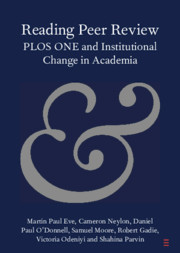48 results
Empowering the Participant Voice (EPV): Design and implementation of collaborative infrastructure to collect research participant experience feedback at scale
-
- Journal:
- Journal of Clinical and Translational Science / Volume 8 / Issue 1 / 2024
- Published online by Cambridge University Press:
- 06 February 2024, e40
-
- Article
-
- You have access
- Open access
- HTML
- Export citation
Fish–parasite interaction networks reveal latitudinal and taxonomic trends in the structure of host–parasite associations
-
- Journal:
- Parasitology / Volume 149 / Issue 14 / December 2022
- Published online by Cambridge University Press:
- 30 June 2022, pp. 1815-1821
-
- Article
-
- You have access
- Open access
- HTML
- Export citation
Balloon dilatation versus surgical valvotomy for congenital aortic stenosis: a propensity score matched study
- Part of
-
- Journal:
- Cardiology in the Young / Volume 31 / Issue 12 / December 2021
- Published online by Cambridge University Press:
- 16 April 2021, pp. 1984-1990
-
- Article
- Export citation
7 - Evolution of the Systems Ecology Paradigm in Managing Ecosystems
-
-
- Book:
- Natural Resource Management Reimagined
- Published online:
- 25 February 2021
- Print publication:
- 11 March 2021, pp 202-244
-
- Chapter
- Export citation

Reading Peer Review
- PLOS ONE and Institutional Change in Academia
-
- Published online:
- 01 January 2021
- Print publication:
- 04 February 2021
-
- Element
-
- You have access
- Open access
- HTML
- Export citation
Neutron Star Extreme Matter Observatory: A kilohertz-band gravitational-wave detector in the global network
- Part of
-
- Journal:
- Publications of the Astronomical Society of Australia / Volume 37 / 2020
- Published online by Cambridge University Press:
- 05 November 2020, e047
-
- Article
-
- You have access
- HTML
- Export citation
Demographic, spatial and temporal dietary intake patterns among 526 774 23andMe research participants
-
- Journal:
- Public Health Nutrition / Volume 24 / Issue 10 / July 2021
- Published online by Cambridge University Press:
- 29 June 2020, pp. 2952-2963
-
- Article
-
- You have access
- HTML
- Export citation
An ultra-wide bandwidth (704 to 4 032 MHz) receiver for the Parkes radio telescope
-
- Journal:
- Publications of the Astronomical Society of Australia / Volume 37 / 2020
- Published online by Cambridge University Press:
- 08 April 2020, e012
-
- Article
-
- You have access
- HTML
- Export citation
Aminochronology and time averaging of Quaternary land snail assemblages from colluvial deposits in the Madeira Archipelago, Portugal
-
- Journal:
- Quaternary Research / Volume 92 / Issue 2 / September 2019
- Published online by Cambridge University Press:
- 03 April 2019, pp. 483-496
-
- Article
- Export citation
Pooled subsidence records from numerous wells reveal variations in pre-break-up rifting along the proximal domains of the Iberia–Newfoundland continental margins
-
- Journal:
- Geological Magazine / Volume 156 / Issue 8 / August 2019
- Published online by Cambridge University Press:
- 22 November 2018, pp. 1323-1333
-
- Article
- Export citation
Habitat associations and distribution model for Fuscopannaria leucosticta in Nova Scotia, Canada
-
- Journal:
- The Lichenologist / Volume 50 / Issue 4 / July 2018
- Published online by Cambridge University Press:
- 23 July 2018, pp. 487-497
- Print publication:
- July 2018
-
- Article
-
- You have access
- HTML
- Export citation
Vanadium Oxide Thin Film by Aqueous Spray Deposition
-
- Journal:
- MRS Advances / Volume 3 / Issue 45-46 / 2018
- Published online by Cambridge University Press:
- 10 July 2018, pp. 2777-2782
- Print publication:
- 2018
-
- Article
- Export citation
6 - Disaster Monitoring
-
-
- Book:
- Twitter: A Digital Socioscope
- Published online:
- 05 May 2015
- Print publication:
- 05 May 2015, pp 131-160
-
- Chapter
- Export citation
Cerebral Abscess Crossing Midline
-
- Journal:
- Canadian Journal of Neurological Sciences / Volume 39 / Issue 2 / March 2012
- Published online by Cambridge University Press:
- 02 December 2014, pp. 236-238
-
- Article
-
- You have access
- Export citation
Carotid Dissection: Technical Factors Affecting Endovascular Therapy
-
- Journal:
- Canadian Journal of Neurological Sciences / Volume 29 / Issue 1 / February 2002
- Published online by Cambridge University Press:
- 02 December 2014, pp. 54-60
-
- Article
-
- You have access
- Export citation
Contributors
-
-
- Book:
- Emergency Department Leadership and Management
- Published online:
- 05 December 2014
- Print publication:
- 27 November 2014, pp ix-xii
-
- Chapter
- Export citation
The Establishment of a Brain Bank for the Study of Late-life Depression: A Feasibility Study of Factors Facilitating Consent
-
- Journal:
- CNS Spectrums / Volume 7 / Issue 11 / November 2002
- Published online by Cambridge University Press:
- 07 November 2014, pp. 816-821
-
- Article
- Export citation
Contributors
-
-
- Book:
- Acute Medicine
- Published online:
- 05 November 2014
- Print publication:
- 30 October 2014, pp viii-x
-
- Chapter
- Export citation
Contributors
-
-
- Book:
- Essentials of Global Mental Health
- Published online:
- 05 March 2014
- Print publication:
- 27 February 2014, pp x-xiv
-
- Chapter
- Export citation
Contributors
-
-
- Book:
- The Cambridge Companion to Ancient Rome
- Published online:
- 05 September 2013
- Print publication:
- 29 August 2013, pp xiv-xix
-
- Chapter
- Export citation




